AI Trends in Healthcare: Use Cases, Benefits, and Challenges
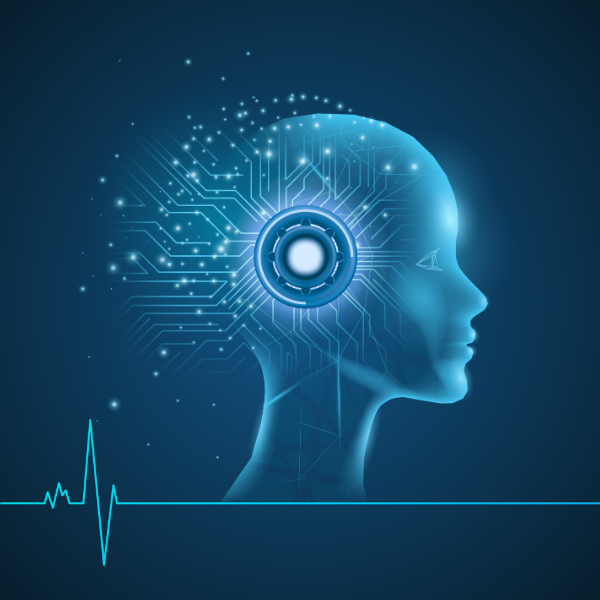
Let’s talk about AI in healthcare. You’ve probably seen the numbers. $360 billion in potential savings for U.S. healthcare. A $188 billion global market by 2030. Up to 30% of work hours across the economy could be automated. But is all this just hype?
With 85% of health system leaders citing AI as the most exciting emerging technology — and the same percentage exploring or already adopting generative AI tools — it appears to be less of a passing trend and something that might actually hold quite a bit of value.
Since the pandemic, healthcare institutions have been struggling with its lasting impact. That includes rising shortages, rampant turnover, and widespread burnout. Paired with margin pressures and ongoing recruitment and retention challenges, many health leaders are turning to technology to ease the strain brought upon their teams. For many, that answer might be AI.
Intelligent, AI-powered models can be used in a variety of ways to improve employee workloads and enhance the patient journey. This includes streamlining administrative tasks, detecting patient disease, discovering new drugs, personalizing treatments based on genetics, monitoring patients remotely, and much more (as we'll soon see!).
This kind of strategic support helps free up valuable time in an industry facing staffing deficits and growing care demand. It also plays an imperative role in delivering more efficient and precise care, from diagnosis to treatment and follow up.
In this blog, we’re taking a comprehensive look at AI trends in healthcare. We’ll explore market growth, current use cases, key benefits, and frequent challenges in adopting AI.
Healthcare AI Market Growth
As overhyped as AI can sound, it is drawing serious investments in healthcare, and these investments have great potential to transform healthcare delivery. Between 2019 and 2022 alone, more than $31.5 billion in private equity went into healthcare AI. Even more remarkable is that the global healthcare market is expected to hit $188 billion by 2030. Even tech giants like Amazon, Apple, and Microsoft are expanding into healthcare AI, betting big on its future.
So, where is all that funding going? According to the American Hospital Association (AHA), here’s how AI investments are being distributed:
- $12.9B – Therapeutics and Research: Drug discovery, clinical trials, and treatment innovation
- $12.3B – Clinical Applications: Diagnostics, patient stratification, imaging, and remote monitoring
- $6.6B – Administrative Tools: Virtual assistants, notetakers, EHR automation, and revenue cycle operations
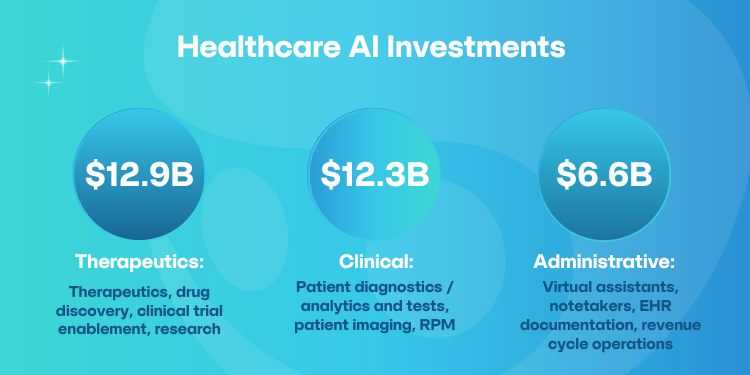
AI Usage: Current State and Future Plans
The current use of AI-powered systems looks different across healthcare organizations. Some are just starting out with small pilots, while others are applying it system-wide. Still, the healthcare industry falls below average in AI adoption in comparison to other industries.
Current State
So far, AI is mostly used on the administrative side. That includes things like documentation, backend support, and improving operations, rather than diagnosis or direct treatment. But as we’ll see, its use in diagnosing and other clinical areas is steadily rising.
In a 2025 analysis of healthcare leaders and their AI usage, it was found that its current use includes clinical care, ambient speech recognition, as well as communication and messaging (Figure 1).
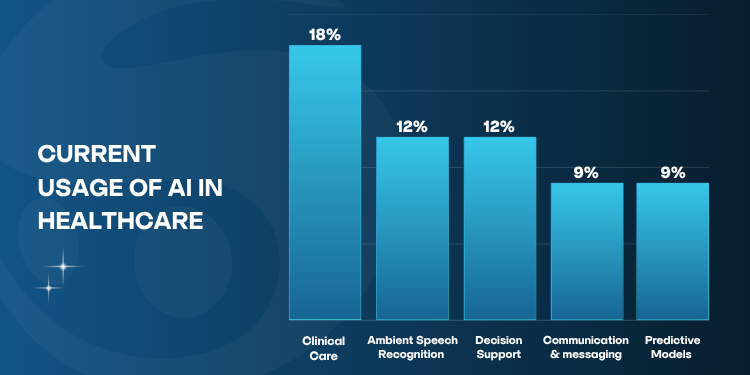
Future State
In the same analysis, healthcare leaders identified their top future planned usages of AI which included Remote Patient Monitoring (RPM), clinical demand centers, and medication management (Figure 2).
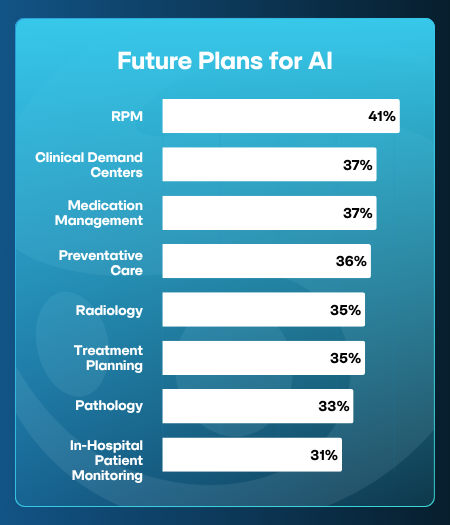
Why it Matters
So, what are healthcare leaders hoping to get from all of this? One report cited that executives hoped to gain increased operational efficiencies, improved consumer experiences, and reduced enterprise costs (Figure 3).
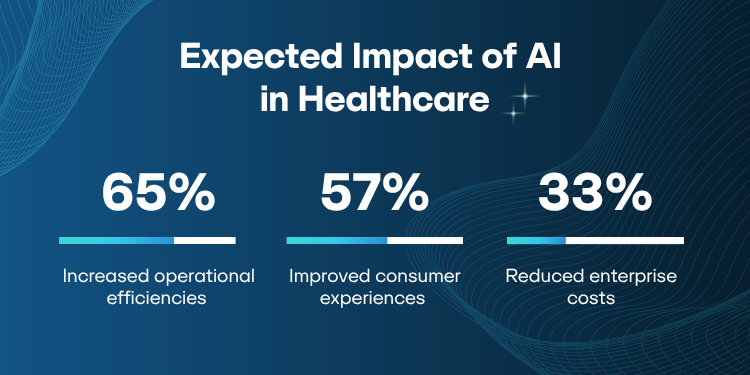
AI Use Cases
Here are some key AI use cases in healthcare we’re seeing applied today:
- Disease Detection
- Remote Patient Monitoring (RPM)
- Precision Medicine
- Administrative Processes
- Communication & Patient Engagement
- Triage & Clinical Decision-Making
- Managing and Leveraging Big Data
- Clinical Lab Testing
- Workforce and Resource Optimization
- Supply Chain Management
- Therapeutics and Research
1. Disease Detection
As scary as it sounds, diagnostic errors can occur more often than expected, affecting an estimated 5% of adults in outpatient care and contributing to 6 to 17% of adverse events in hospitals.
Diagnosing diseases can be particularly challenging for physicians. That’s because disease mechanisms and symptoms are often subtle and complex. In many cases, even experienced providers can find it hard to pinpoint a disease in its early stages.
This is where AI models are proving to be incredibly useful. AI systems can analyze vast amounts of clinical data from a host of different sources, including medical images (like X-rays or MRI scans), lab results, Electronic Health Records (EHRs), patient conversation notes, biometric readings, wearable sensors and more. By sifting through large volumes of clinical data, AI-powered technologies are trained to detect patterns or markers that could signal disease. They can even pick up on subtle signs that might otherwise be missed by the naked eye.
AI, however, is also showing promise in discovering the presence of diseases before symptoms even appear. It’s able to recognize early signatures in an individual predictive of developing conditions like Alzheimer’s or kidney disease.
Combining AI with provider expertise enables a more holistic approach to diagnosis. Intelligent software systems can assist physicians and radiologists in diagnosing faster, with greater context from available data, and with improved accuracy, allowing patients to receive care sooner, before disease onset worsens.
Some of the biggest applications of AI in healthcare diagnostics include mining unstructured data and medical imaging.
1. Mining Unstructured Data
We know that AI algorithms are able to process large, structured data sets, but a critical advantage it also has, is its ability to analyze unstructured data. Unstructured data simply means it’s a form of data that doesn’t neatly fit into a database or spreadsheet (think columns and rows). Unstructured data consists of medical images, clinical notes, and audio transcripts. The problem is, is that unstructured data is often messy and difficult to interpret manually. Since nearly 80% of healthcare data is unstructured, a huge amount of insightful information is often overlooked. This data frequently captures the nuances of disease, symptoms, and context.
AI software can untangle complex datasets to extract critical information that supports:
- Support diagnosis
- Predict outcomes
- Identify high-risk patients
- Personalize treatment plans
2. Medical Imaging
Medical imaging is one of the most exciting and powerful applications of AI. These tools are trained to assess radiological images, including X-rays, MRI’s, PET and CT scans, and electrocardiograms, to detect irregularities like cancers, strokes, and bone fractures. Algorithms learn from thousands of images, recognizing anomalies that sometimes even experienced clinicians are susceptible to miss.
This kind of technology will be key in reducing diagnostic errors and speeding up detection, which will be imperative in time-sensitive situations, such as strokes and brain bleeds, where every minute counts.
Below are some exciting studies demonstrating AI’s remarkable diagnostic capabilities with radiological images:
Case Example 1: Breast Cancer
A study in South Korea found that AI diagnosed breast cancer with 91% accuracy, outperforming radiologists who scored 74%. It’s important to note that breast cancer can be very subtle and difficult to detect. Training AI over thousands of datasets helps radiologists identify these subtle tissue changes. Several mammography cancer detection tools are already in use across health systems, with the first FDA approved program being iCAD’s ProFound AI.
Case Example 2: Skin Cancer
In a study published in Annals of Oncology, researchers in Germany, France, and the United States trained a convolutional neural network (CNN) on over 100,000 images to identify skin cancer. When tested against 58 international dermatologists, the AI missed fewer melanomas and misdiagnosed benign moles less often.
Case Example 3: Brain Scans
In the United Kingdom, three universities trained an AI software to examine brain scans of stroke patients. The AI was twice as accurate as professionals and could even estimate the timescale of the stroke event, which is critical for determining whether a patient is eligible for certain surgical interventions.
2. Remote Patient Monitoring (RPM)
The AHA identified Remote Patient Monitoring (RPM) as the top planned use of AI, with 41% of healthcare leaders identifying it as a key area of focus (Figure 2). This means pairing AI with RPM devices, such as smart watches, biosensors, sleep monitors, digital glucometers, blood pressure cuffs, and pulse oximeters.
Such devices allow care providers to continuously monitor patients’ vital signs and health conditions in real time. When paired with AI, data from these devices can be instantly analyzed to identify patterns, detect potential complications, and flag any irregularities before they escalate.
AI-connected RPM solutions will be especially valuable for managing chronic conditions like heart disease, diabetes, and hypertension and can help reduce unnecessary hospital visits. In fact, one 2025 study found that remote monitoring already reduced hospital readmissions by up to 59%. With AI integration, those results could become even more impactful.
Some leading AI-enabled RPM solutions include:
- AliveCor: Offers ECG hardware and software for mobile devices to remotely monitor heart rhythm and detect arrhythmias.
- Medsien: Provides RPM tools such as glucometers, blood pressure cuffs, pulse oximeters, and digital scales.
3. Precision Medicine
Imagine receiving treatment tailored to your unique genetic makeup, lifestyle, environment and biomarkers. This is precision medicine and with AI’s assistance, it’ll soon become a reality. How it works is that smart algorithms are able to digest complex datasets, including genomic and gene expression data, which can then be used to predict how a patient might respond to certain treatments.
This enables care plans that are more targeted, personalized, and ultimately more effective for the individual patient. It also means less trial-and-error prescribing, fewer unnecessary side effects, better medication matches, and patients getting treated faster.
What’s fascinating is seeing this play out in practice. For instance, one study trained a machine learning model on patients’ gene expression data and successfully predicted their responses to chemotherapy, achieving over 80% accuracy across several drugs.
Another case example is Memorial Sloan Kettering Cancer Center (MSKCC) developing an AI system called “Watson for Oncology” in collaboration with IBM Watson Health. Their solution analyzes medical records and genomic data to provide personalized cancer treatments. In a study of over 1,000 breast cancer cases, its recommendations matched the tumor board’s 93% of the time.
4. Administrative Processes
What’s the most immediate and near-term use of AI in healthcare? Automating and streamlining administrative processes. With healthcare workers spending up to 28 hours weekly on administrative tasks—and for doctors it can eat up to two-thirds of their time—AI’s most impactful role right now is to lighten that load. According to the AHA, AI could automate nearly 30% of work hours by 2030. That has profound implications for easing burnout, reducing manual (and costly!) errors, and freeing up time to deliver quality care.
So, what does AI’s role in relieving administrative processes look like? It means automating routine tasks such as:
- Reviewing and summarizing patient records
- Handling documentation
- Scheduling appointments
- Patient check-ins and registration
- Data entry
- Medical coding, billing, and claims management
Two key areas where AI is already making a difference are clinical documentation and revenue cycle management.
1. Clinical Documentation
AI-powered notetaking tools, like ambient listening systems, can tune into conversations during appointments and generate clinical notes in real time. These systems help document the encounter, summarize patient visits, and even write up care plans or follow-up instructions. In recent years, provider interactions have often meant tapping away at a screen during appointments. Now, documentation software is helping providers spend more face-to-face time and deliver personalized care.
2. Revenue Cycle Management
We know how painfully time-consuming revenue cycle processes are. However, with AI assisting in billing, coding, reimbursements, prior authorizations and claims management, organizations are experiencing shorter waiting times, fewer denials, and improved accuracy. For example, Tryon Medical Partners now automates 90% of its prior authorization requests, with denial rates below 2%. Before AI models, the process was entirely manual, leading to long delays and frustrated patients.
5. Communication & Patient Engagement
What’s more frustrating than broken communication in a time of need? For patients this can be risky. That’s where AI-powered chatbots come in. These tools offer 24/7 support, helping strengthen the patient experience, improve engagement, and lead to better care outcomes.
Already in use in approximately 46% of medical practices as of 2023, chatbots assist with scheduling appointments, paying bills, refilling prescriptions, and accessing medication information. Some chatbot even offer multilingual support, making it easier for patients from different backgrounds to stay informed.
And the payoff is there. Sixty-eight percent of practices reported a positive return on investment from chatbot integration, while 55% of those using chatbots for patient self-scheduling have saved at least an hour per week.
By handling routine questions, chatbots free up valuable staff time and keep patients connected and informed. Supporting and empowering patients enables them to stay engaged in their care.
6. Triaging and Clinical Decision-Making
One unexpected (but incredibly useful) application of AI in healthcare? Triage. AI can assist care teams in real time by helping prioritize urgent medical cases and flagging high-risk patients who need immediate attention. It can also quietly kick off critical workflows behind the scenes—prepping rooms, notifying teams, and coordinating equipment—all before a patient even arrives.
Let’s walk through a scenario to see this in action. Say a patient is showing signs of a stroke while en route to the ER. An AI system picks up red flags from pre-hospital data and triggers a series of alerts: the care team is notified, a bed is prepped, imaging equipment is ready, and stroke specialists are looped in. This kind of time efficiency is critical in conditions where every second is essential.
Beyond logistics, AI in triage can also reduce bias in decision-making, optimize resource use, and streamline emergency department operations. By getting the right care to patients faster, AI-driven triage directly improves outcomes, reduces complications, and can potentially save lives.
One study analyzing over 166,000 ER encounters found that the AI triage model KATE™ outperformed the average triage nurse by nearly 27% in predicting ESI acuity assignments, with an accuracy of 76% compared to 60% for nurses. This shows its potential strength in distinguishing between acuity levels.
7. Managing and Leveraging Big Data
Deloitte’s newest 2025 report found that the global health care sector generated more than 2.3 zettabytes of data in 2020 alone. That’s 2.3 trillion gigabytes! With an explosion of information continuously pouring in — for example, dermatology sees 11,000 new research articles published each year — staying afloat with that level of data, studies, and research is humanly impossible.
Leveraging AI systems to make sense of such an excess of data is becoming absolutely essential. Rather than drowning in information, teaming up with AI means healthcare can actually start using these valuable insights in actionable, meaningful ways towards patient care
8. Clinical Lab Testing
One unexpected application of AI is in clinical laboratory testing, including areas such as pathology and microbiology. It’s being used to improve the accuracy, speed, and efficiency of lab processes, leading to faster diagnosis and treatment.
In microbiology, for example, machine learning (ML) models are helping detect and quantify microorganisms, assist with gene sequencing, and analyze microscopic images. Advances to lab processes help them deliver results with greater precision and support personalized treatment.
One LLM model being used in lab testing and pathology comes from Germany, where a pathology platform called Elea has cut testing and diagnosis times from weeks down to hours. The platform transcribes assessment dictations, checks them, and validates findings reports in under 30 seconds (fully automatic, with no human typist involved).
9. Workforce and Resource Optimization
The shortages that don’t seem to end, the turnover cycling through teams, and the burnout of remaining staff — it’s been a vicious cycle dragging on well after the pandemic. In the face of these workforce challenges, hospitals are also left tackling rising cost pressures and growing care demand, all with a workforce wearing thin.
Employing AI solutions help relieve some of these workforce challenges. Intelligent systems can be strategically used to predict patient demand, automate key recruitment tasks, and generate smart scheduling to optimize workforce use.
Specifically, AI is transforming workforce management through:
- Predictive Staffing and Capacity Planning: AI uses historical data and real-time inputs to forecast patient demand, helping hospitals plan staffing levels in advance and reduce coverage gaps, ensuring patients receive care during seasonal spikes.
- AI in Recruitment: AI streamlines hiring by scanning resumes, sourcing candidates, and matching them to roles, speeding up the process and improving the quality of hires and bringing in qualified talent faster to fill critical roles.
- Automated Scheduling and Shift Optimization: AI-driven tools, like StaffBot Flex, generate optimized shift schedules based on staff availability, skill sets, and patient needs, cutting down manual work and improving staff satisfaction.
Tools like our AI-powered self-serve scheduling app, StaffBot Flex, help healthcare leaders balance workloads, reduce agency reliance, and prevent burnout. Explore how StaffBot Flex enables smarter scheduling and happier teams.
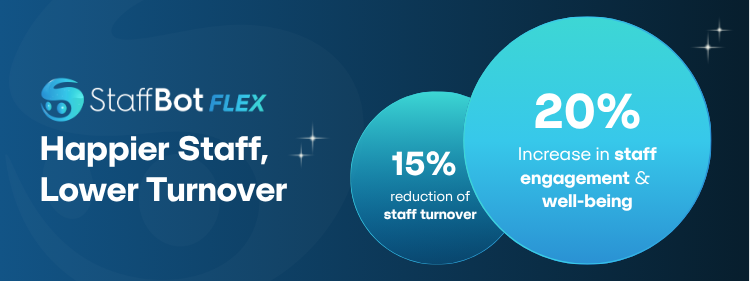
10. Supply Chain Management
The burning conundrum many hospitals face: order too little and risk running out of critical supplies, or order too much and watch unused stock expire on the shelf. Managing inventory manually can be time-consuming, error-prone, and reactive. Yet supplies like medications, vaccines, and clinical tools are critical to have on hand in order to deliver safe, quality care.
Turning to predictive analytics changes all of this. By accounting for historical usage data, patient volumes and seasonal health trends, AI can forecast demand more precisely, allowing hospitals to order the right amount. Some systems may even trigger automatic reorders when supplies begin to dip below a certain threshold. Smarter, data-driven inventory management reduces waste, cuts costs, and keeps the supply chain efficient and well-stocked.
11. Therapeutics and Research
Therapeutics and research represent the largest area of investment for AI in healthcare, with nearly $13 billion focused on drug discovery, clinical trials, and related fields. These technologies are helping to streamline processes that have traditionally been slow and costly. Two key areas where AI is making a significant impact are drug discovery and clinical trials.
1. Drug Discovery
As mentioned (several times) before, AI excels at mining vast and complex datasets and this capability can be further applied to analyzing biological and chemical data to identify molecular compounds with properties that may help treat disease. Rather than relying on traditional trial-and-error methods, AI models can simulate how diseases function at a molecular level, helping unearth opportunities for intervention. Intelligent drug discovery systems will help speed up preclinical testing, improve precision, and reduce the time and cost associated with bringing new treatments to the market.
2. Clinical Trials
Clinical trials are notoriously hard to carry out. Around 80% fail to meet enrollment deadlines, and more than half get shut down because they can’t enroll enough participants. One of the biggest challenges? Finding people who meet the strict requirements to join.
AI can help by scanning large amounts of health data, like medical records or lab results, to identify potential candidates who fit the criteria. This saves time, speeds up recruitment, and can even help include more diverse and representative patients. This helps make clinical trials more efficient and effective, benefiting both researchers and patients.
Benefits of AI in Healthcare
Having covered the many use cases of AI in healthcare, here’s a look at the broader benefits of employing it within healthcare practice:
- $360B in potential savings, according to Deloitte
- Reduces unnecessary visits and readmissions
- Enables proactive, preventive care
- Improves diagnosis accuracy and decision-making
- Eases pressure from workforce shortages
- Cuts administrative burden and human error
- Manages care at scale across large patient populations
- Connects fragmented healthcare data for more informed decisions
- Frees up time for face-to-face patient care
Together, these benefits show that AI can help healthcare shift from reacting to problems toward planning ahead. This leads to better care, smoother operations, and a more complete approach to health for everyone.
Challenges in Implementing AI
As a powerful tool, AI also comes with its own challenges, particularly in healthcare where information and care are sensitive. That can make it difficult for health systems to integrate it.
Some of the key challenges include:
- Cost: AI can be expensive. In a 2023 survey, 46% of healthcare leaders said cost was a top barrier.
- Data Privacy and Security: Hospitals need to make sure AI follows privacy laws and protects sensitive information from leaks or misuse.
- Patient Safety: AI has to be reliable and safe. Mistakes or unexpected results could harm patients, so systems need careful testing and ongoing checks.
- Accuracy: AI relies on good data. If the data is wrong or incomplete, AI can give bad advice that affects care.
- Integrating with Existing Systems: Many hospitals use old systems that don’t easily work with new AI tools. This makes it difficult to set up AI efficiently.
- Compliance: AI tools have to meet laws like HIPAA and FDA requirements, which can be complicated.
- Bias Issues: AI can pick up and repeat biases in its training data. If not managed, this can lead to unfair care.
- Trust and Adoption of Providers: Doctors and staff need to trust AI and see how it helps. Without that, they might not use it or resist it.
Conclusion
With all the hype surrounding AI, we wanted to take a comprehensive look at what AI means for healthcare. AI solutions offer real hope to health systems struggling to deliver care while coping with challenges like tight margins, workforce shortages, turnover, and burnout.
It also has powerful implications for the future of health care delivery. From more precise diagnoses, to making sense of complex data and personalizing treatments, AI models will help improve daily work for care teams, lead to better outcomes for patients, and support proactive health strategies.
For organizations, it will help improve margins, streamline operations, and take pressure off of employees. As AI-tools continue to integrate into healthcare, we’re excited to see what comes next.
AI-Powered Self-Serve Scheduling for Healthcare Workers
AI in healthcare isn’t just something to look forward to. It’s already here.
Our self-serve scheduling platform, StaffBot Flex, is built to give nurses more control to choose shifts that work for them, creating more flexibility and a better work-life balance.
StaffBot Flex also helps health organizations use their internal resource pool more effectively. With smart algorithms, scheduling can be optimized across units and locations in one place.
With StaffBot Flex, health systems can:
• Improve retention and lower turnover by 15%
• Enhance worker engagement by 20%
• Save up to 4 hours of daily administrative time
• Cut costs up to 5% within the first year
• Reduce dependence on contract labor
Curious how it works? Let’s show you around the app. Schedule a 15-minute demo with our team. Sign up here!
